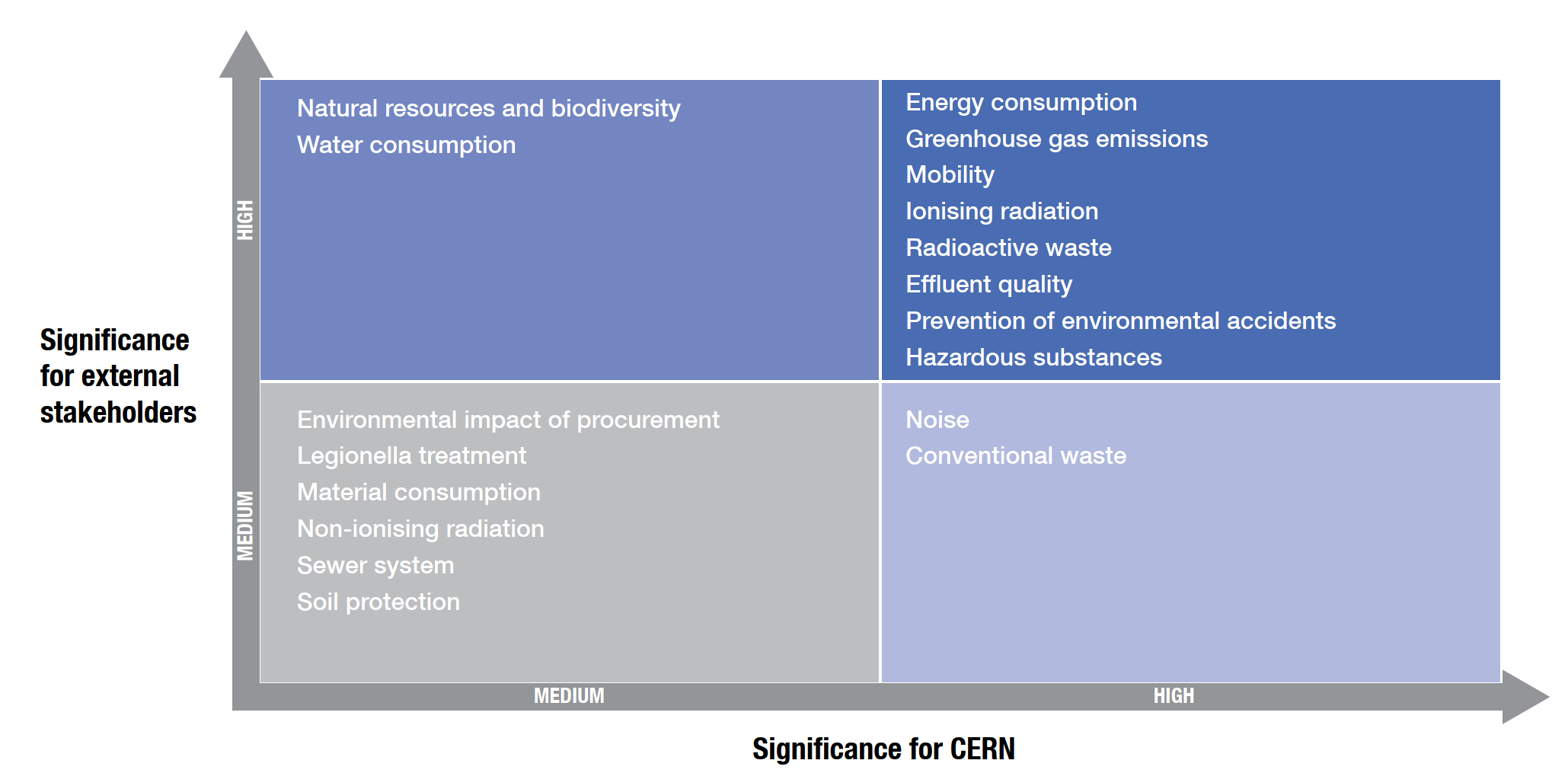A strategy for the environment
CERN strives to be a role model for environmentally responsible research and is committed to minimising its environmental impact. CERN’s Safety Policy covers all matters relating to health, safety and environmental protection, and includes the explicit goal of limiting the impact of the Organization’s activities on the environment. The Occupational Health and Safety and Environmental Protection unit (HSE) is CERN’s centre of competence in environmental matters and the driving force behind the Safety Policy. In addition to the Safety Policy, CERN has adopted an Environmental Protection Strategy that continuously identifies and sets out action plans for prioritised environmental protection domains.
CERN applies the precautionary principle in all aspects of environmental management, taking action to avoid the possibility of serious environmental impact. This applies under all circumstances: if the scientific data does not permit a complete evaluation of the risk, precautionary measures are nevertheless deployed.
Specialised tools and bodies
CERN has established a range of bodies to manage its environmental footprint. As part of the Environmental Protection Strategy, the Organization launched the CERN Environmental Protection Steering Board (CEPS) in 2017. CEPS’s mandate is to identify and prioritise environmental areas to be addressed and to propose programmes of action. Objectives are approved at the highest level of management at CERN, the Enlarged Directorate. CEPS follows up on the implementation of the programme after endorsement and allocation of resources by the Directorate. During 2019 and 2020, CEPS steered the action plan related to objectives set in 2017 and established working groups on the management of biodiversity, waste and fluorinated gases at CERN. As with any other objective of the Organization, milestones and deadlines for environment-related projects may be delayed due to unforeseen circumstances. This was the case for some of CEPS’s recommendations due to the COVID-19 pandemic. For example, during the second long shutdown (LS2), the experiments launched a leak repair campaign. Not all planned repairs could be executed but the campaign remains a priority.
The Energy Management Panel (EMP) was established in 2015. It examines CERN’s energy consumption, identifies measures to improve efficiency and promotes energy re-use.
CERN has developed several environmental management tools, including the Radiation Monitoring System for the Environment and Safety (RAMSES) (see Ionising radiation) and the CERN Chemical Register for Environment, Health and Safety (CERES) (see Environmental compliance).
In 2020, the EIROforum created an ad-hoc group on the environment, which is chaired by CERN. This group aims to review the environmental activities carried out by each EIROforum member and to identify areas of common interest where synergies could be developed.
Collaboration with the Host States
CERN works closely with its Host States in matters of environmental protection. As an organisation straddling two countries, CERN develops its own regulations, based on and in agreement with those of the Host States. Where no specific CERN regulation exists, the most relevant regulation of the two Host States is adopted.
Together with the Canton of Geneva, Switzerland, and the Prefecture of Ain, France, CERN established a tripartite committee for the environment under a memorandum of cooperation on non-radiological environmental aspects in 2007. It holds two plenary meetings per year as well as regular technical meetings.
The Laboratory signed a tripartite agreement on radiation protection and radiation safety in 2010 with the Swiss Federal Office of Public Health (OFSP) and the French Nuclear Safety Authority (ASN). This replaced previously existing bilateral agreements and created a legal framework for discussing topics related to radiation protection. The agreement provides for regular technical meetings as well as high-level plenary meetings chaired by CERN’s Director of Accelerators and Technology. In addition, the Organization formally reports to the OFSP and ASN on matters of radiation protection and, in particular, the environmental aspects thereof.
Materiality

In preparation for its first environment report, CERN carried out a materiality analysis based on internal and external stakeholder dialogues. The result was a set of topics and disclosures that are also covered in this report and are drawn from the GRI Sustainability Reporting Standards, as well as some CERN-specific topics not covered by the GRI Standards but deemed by CERN and key stakeholders to be of material importance in the CERN context.
The process began with topic-prioritisation focus group meetings with internal stakeholders chosen to represent the diversity of viewpoints at CERN. External stakeholders were identified based on the insight from these meetings, and they were then interviewed (GRI 102-43). A full list of the stakeholders consulted can be found in the CERN Environment Report for 2017-2018.
The materiality matrix (GRI 102-44) shows the resulting list of topics deemed of high significance to CERN by internal and external stakeholders (GRI 102-47). These are the focus of the report.
Following the publication of CERN’s first public-facing environment report, a question was raised in CERN’s Scientific Policy Committee in 2020 about helium consumption, along with a request to report on the subject in this report (see Environmental compliance) (GRI 102-44).
Topic boundaries
CERN is an intergovernmental organisation that also functions as a user facility for people and equipment from universities and institutes around the world. The data presented in the report refers exclusively to the impact of CERN’s facilities in the Geneva region, unless stated otherwise. The production of research equipment under the responsibility of collaborating institutes is not considered here (GRI 102-46).
CERN’s main product is data, which is transformed into knowledge by scientists around the world using the Worldwide LHC Computing Grid (WLCG) (see Energy). This is a distributed network and is covered here only insofar as the facilities are owned or operated by CERN.
Learn more
Questions regarding this report may be addressed to environment.report@cern.ch.
